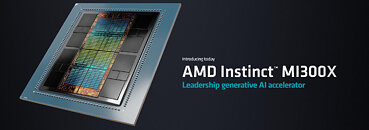T0@st
News Editor
- Joined
- Mar 7, 2023
- Messages
- 3,328 (3.87/day)
- Location
- South East, UK
| System Name | The TPU Typewriter |
|---|---|
| Processor | AMD Ryzen 5 5600 (non-X) |
| Motherboard | GIGABYTE B550M DS3H Micro ATX |
| Cooling | DeepCool AS500 |
| Memory | Kingston Fury Renegade RGB 32 GB (2 x 16 GB) DDR4-3600 CL16 |
| Video Card(s) | PowerColor Radeon RX 7800 XT 16 GB Hellhound OC |
| Storage | Samsung 980 Pro 1 TB M.2-2280 PCIe 4.0 X4 NVME SSD |
| Display(s) | Lenovo Legion Y27q-20 27" QHD IPS monitor |
| Case | GameMax Spark M-ATX (re-badged Jonsbo D30) |
| Audio Device(s) | FiiO K7 Desktop DAC/Amp + Philips Fidelio X3 headphones, or ARTTI T10 Planar IEMs |
| Power Supply | ADATA XPG CORE Reactor 650 W 80+ Gold ATX |
| Mouse | Roccat Kone Pro Air |
| Keyboard | Cooler Master MasterKeys Pro L |
| Software | Windows 10 64-bit Home Edition |
AMD recently revealed its Instinct MI300X GPU at their Data Center and AI Technology Premiere event on Tuesday (June 15). The keynote presentation did not provide any details about the new accelerator model's power consumption, but that did not stop one tipster - Hoang Anh Phu - from obtaining this information from Team Red's post-event footnotes. A comparative observation was made: "MI300X (192 GB HBM3, OAM Module) TBP is 750 W, compared to last gen, MI250X TBP is only 500-560 W." A leaked Giga Computing roadmap from last month anticipated server-grade GPUs hitting the 700 W mark.
NVIDIA's Hopper H100 took the crown - with its demand for a maximum of 700 W - as the most power-hungry data center enterprise GPU until now. The MI300X's OCP Accelerator Module-based design now surpasses Team Green's flagship with a slightly greater rating. AMD's new "leadership generative AI accelerator" sports 304 CDNA 3 compute units, which is a clear upgrade over the MI250X's 220 (CDNA 2) CUs. Engineers have also introduced new 24G B HBM3 stacks, so the MI300X can be specced with 192 GB of memory (as a maximum), the MI250X is limited to a 128 GB memory capacity with its slower HBM2E stacks. We hope to see sample units producing benchmark results very soon, with the MI300X pitted against H100.



View at TechPowerUp Main Site | Source
NVIDIA's Hopper H100 took the crown - with its demand for a maximum of 700 W - as the most power-hungry data center enterprise GPU until now. The MI300X's OCP Accelerator Module-based design now surpasses Team Green's flagship with a slightly greater rating. AMD's new "leadership generative AI accelerator" sports 304 CDNA 3 compute units, which is a clear upgrade over the MI250X's 220 (CDNA 2) CUs. Engineers have also introduced new 24G B HBM3 stacks, so the MI300X can be specced with 192 GB of memory (as a maximum), the MI250X is limited to a 128 GB memory capacity with its slower HBM2E stacks. We hope to see sample units producing benchmark results very soon, with the MI300X pitted against H100.



View at TechPowerUp Main Site | Source






